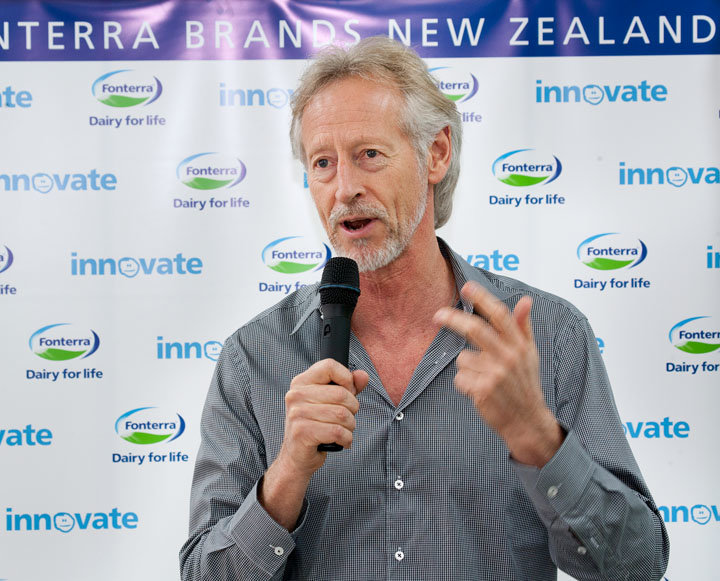
After more than a decade as managing director at SC Johnson, three years in the same role at Lion Breweries, then nearly 20 years as the boss of Fonterra Brands, there’s not much Peter McClure doesn’t know about how to launch a product. As he steps down from the role he tells Amanda Sachtleben about grabbing shoppers’ eyeballs in eight seconds, why that lightproof milk bottle wasn’t actually a flop and the reason entrepreneurs have a marketing jump on the corporates.
Supermarket shelves are full of stuff shouting for our attention. How can brands stand a chance of being bought?
It’s getting a lot more difficult. We begin with consumer insights and from those try and determine how we can satisfy consumers’ needs, particularly shoppers. The consumer and the shopper are often two very different people. The purchase decision is often made in store and the final act is often hurried. Research shows the average consumer spends eight seconds in front of the milk chiller, so you have to grab their attention in a very short period.
What’s really pushing buyers’ buttons these days?
There’s a fundamental change taking place. A few years back it would be all about diet, diet drinks and yoghurts, now it’s more about wholesomeness and wellness. But it’s not that simple. In yoghurts, for example, at the same time as there’s this drive towards wellness and low fat and lower sugar options, you’ve also got the opposite going on. A lot of the development and the explosion in the category is in the indulgent end of the market, with companies like Piako and Puhoi Valley. Often you have a trend and a counter trend going on at the same time.
You must have seen some stellar product launches and some stinkers. Why do some work and others fail?
One that went out of the blocks fantastically was Mammoth. It took off. The insight was men stopped eating yoghurt at about 35, and we figured maybe mums were buying it for the family and what she was buying wasn’t that exciting. We came up with a bloke’s yoghurt. It had high fat content and was a man-sized meal. It really targeted men with a tongue in cheek approach. Often these things are about timing. Sometimes you launch something and it doesn’t work and you launch later and it works. At Johnson’s we launched the first ever pump pack of soap and only sold 2000-3000 cases in the first year. We re-launched it as soap on tap, then as softwash, and it took off. When the timing was right, away it went. If you look at it now, there are extensions into shower and bath gels. Try selling one of those 20 years ago.
You copped huge flak over the light proof milk bottle. Was that a winner or a stinker?
We came under amazing attack, there was even a New Zealand Herald editorial on it. We talked about a triple layer bottle and people got the impression there was a lot more plastic, when there wasn’t. A lot of people said they couldn’t see their milk and how much was left. The media just went after us on it. I’d been on television every few months talking about milk prices and people were saying, ‘why don’t you give us cheap milk, we don’t want the flashy bottle.’ All that seems to have dissipated now. We interacted with consumers because we knew they were concerned about recycling. We closed the loop and worked with bottle collectors and found a way for all the Anchor bottles to be processed into bottles, wheelie bins and worm farms, and pipes on farms. Most other bottles are shredded and sent offshore for recycling.
So it’s as much about how a company behaves as the product it sells?
What consumers do more now is look behind the brand. They ask what is the company’s record in recycling, and beyond that on sustainability, how does it treat animals, etc. I’m also chairman of World Vision New Zealand. World Vision had an issue in the US about hiring practices for homosexuals in a married relationship. Within a couple of hours we had supporters here calling us up. Things go viral incredibly quickly. We use digital campaigns all the time now. When you give consumers a format or a context to give feedback, you have to respond very quickly or it can get out of control.
Are demanding digital types just an annoying fact of life now?
Marketers have to get accustomed to consumers owning their brand more and having a sense of ownership in it. In food you have issues daily, like ‘I’ve found a fly in my soup.’ We find 95% of those issues are things that get into the product in the household. Every one of those issues got escalated to me. We have to go through a very rigorous process. If someone said they found a hairclip in their yoghurt, all our products go through x-rays so we can say the one with the hairclip would have been rejected. And we have a digital photo of every pack. The difference is consumers rush to the media with everything. They’re not even interested in hearing the initial communication.
You’ve been part of a corporate marketing machine, but what are your tips for the little guys launching what they hope will be the next big thing?
You’ve got to have a quality product and the capability to support it. And you’ve got to have a point of difference. Supermarkets will tend to encourage new players; it keeps the big guys honest. We’ve seen small guys like Piako come in, and now we manufacture, market and distribute their products. ×




